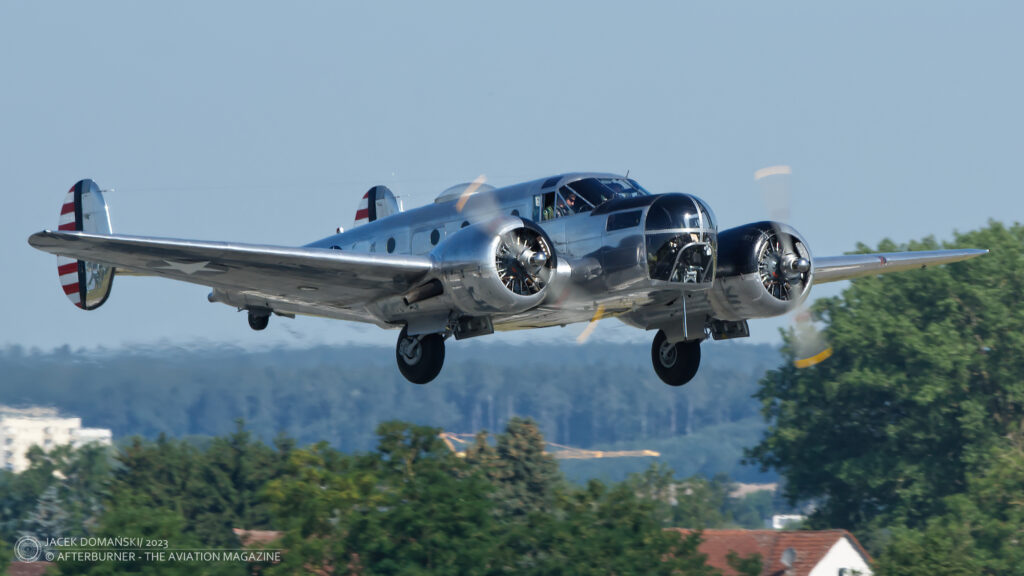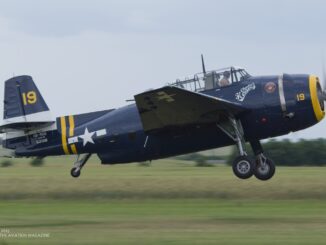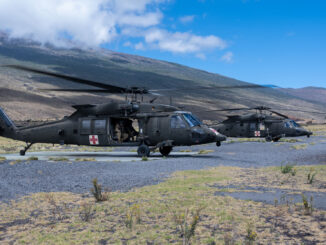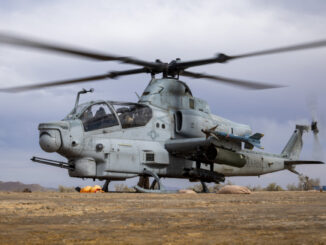 Beechcraft AT-11 Kansan (c/n 4616, formerly 42-37620 USAAF, N15KK), flying display at Mini Tiger Meet 2023, Neuburg a.d. Donau, July 2023.
Beechcraft AT-11 Kansan (c/n 4616, formerly 42-37620 USAAF, N15KK), flying display at Mini Tiger Meet 2023, Neuburg a.d. Donau, July 2023.
In the late 1930s, the Beech Aircraft company developed a new, all-metal light aeroplane, designed in twin-tailfin configuration (with a tail wheel), and powered by two radial engines. The aircraft, designated Beechcraft Model 18, performed its maiden flight on 15th January 1937 and shortly after was approved for serial production (click here for the full history of Beech Model 18).
Although the Model 18 was a well-designed aircraft, its initial sales were very low. Until the end of 1941, less than forty examples of that aircraft were sold totally, with only twenty-nine to civilian customers.
Fortunately for the Beech Aircraft company, the situation changed with the US entry into World War II. The country´s armed forces urgently needed a fleet of modern training aircraft, and the Model 18 came into view as one of the available solutions.
In fact, the ´Twin Beech´, as the aeroplane was commonly nicknamed, turned out to be truly versatile training platform that could be easily converted into bomber crew and navigation trainer, photo-reconnaissance and drone control aircraft, electronic countermeasures trainer, as well as light bomber and light military transport aircraft.
Military variants of the Model 18 included C-45, AT-7 Navigator, CQ-3 and AT-11 Kansan for the United States Army Air Forces, UC-45J Navigator, JRB-1/JRB-3, SNB-3Q and SNB-1 Kansan for the US Navy, as well as M18R light bomber for China. It is believed that more than 4,500 examples of the Beech Model 18 – approximately half of the total production – were acquired and used by military operators.
The AT-11 Kansan became the standard training aircraft for the USAAF bomber crews. Modifications from the basic Model 18 included transparent nose with bombardier seat, internal bomb racks and provisions for two .30 cal flexible machine guns for gunnery training. In the late 1943, the AT-11s in the USAAF service were additionally equipped with Norden Bombsight and C-1 autopilot that allowed bombardier student to control the aircraft during the final stage of bomb run.
During the training, the AT-11 Kansan trainers were usually equipped with 100-pound practice bombs, filled with sand. Minimum accuracy level was set at 22% hits on target.
Between 1941 and 1945, the USAAF operated 1,582 AT-11s, including thirty-six AT-11A navigation trainers. According to official USAAF statements, approximately 90% of the 45,000 US bombardiers were trained with that aircraft, as well as a majority of navigators and gunners.
The aircraft featured today in our Photo of the Week series was built at the end of 1942. In January of 1942 it was taken on strength with the USAAF with military identification number 42-37620 and assigned to Childress AAF Bombardier training school in Texas.
That AT-11 was used by the military until 1954, when it was retired from service and sold to private civilian owner. During the next few decades, the aircraft changed its owners several times. Finally, in the 1990s, ended up on the display at Camp Meade, Vermont – however, in not a good technical condition.
In 2008, the aeroplane was acquired by Heartland of America Museum and, fortunately, reconstruction to airworthy condition began shortly after. In 2015, the restored AT-11 Kansan ’42-37620′ received new civilian registration N15KK. Three years later, the aircraft was purchased by KFG Aviation Inc.



